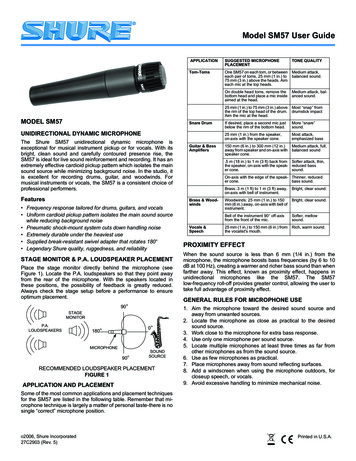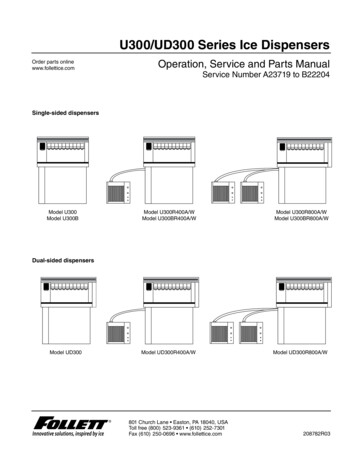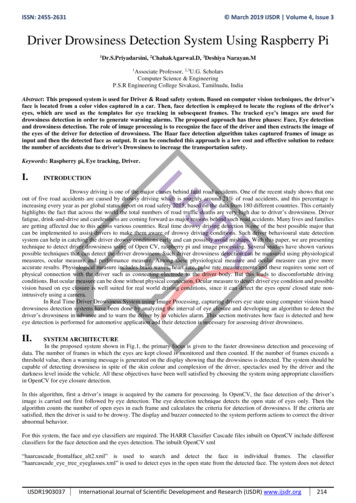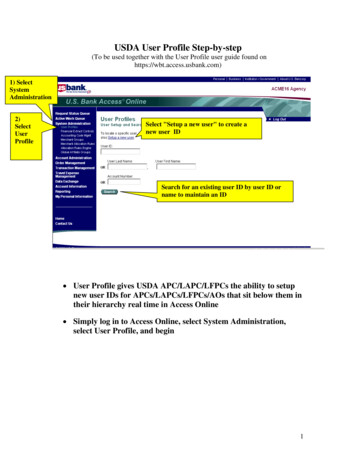
Transcription
Model SM57 User GuideMODEL SM57APPLICATIONSUGGESTED MICROPHONEPLACEMENTTONE QUALITYTom-TomsOne SM57 on each tom, or betweeneach pair of toms, 25 mm (1 in.) to75 mm (3 in.) above the heads. Aimeach mic at the top heads.Medium attack,balanced sound.On double head toms, remove thebottom head and place a mic insideaimed at the head.Medium attack, balanced sound.25 mm (1 in.) to 75 mm (3 in.) abovethe rim of the top head of the drum.Aim the mic at the head.Most “snap” fromdrumstick impactIf desired, place a second mic justbelow the rim of the bottom head.More “snare”sound.25 mm (1 in.) from the speaker,on-axis with the speaker cone.Most attack,emphasized bass150 mm (6 in.) to 300 mm (12 in.)away from speaker and on-axis withspeaker cone.Medium attack, full,balanced soundSnare DrumUNIDIRECTIONAL DYNAMIC MICROPHONEThe Shure SM57 unidirectional dynamic microphone isexceptional for musical instrument pickup or for vocals. With itsbright, clean sound and carefully contoured presence rise, theSM57 is ideal for live sound reinforcement and recording. It has anextremely effective cardioid pickup pattern which isolates the mainsound source while minimizing background noise. In the studio, itis excellent for recording drums, guitar, and woodwinds. Formusical instruments or vocals, the SM57 is a consistent choice ofprofessional performers.Features Frequency response tailored for drums, guitars, and vocals Uniform cardioid pickup pattern isolates the main sound sourcewhile reducing background noise Pneumatic shock-mount system cuts down handling noise Extremely durable under the heaviest use Supplied break-resistant swivel adapter that rotates 180 Legendary Shure quality, ruggedness, and reliabilitySTAGE MONITOR & P.A. LOUDSPEAKER PLACEMENTPlace the stage monitor directly behind the microphone (seeFigure 1). Locate the P.A. loudspeakers so that they point awayfrom the rear of the microphone. With the speakers located inthese positions, the possibility of feedback is greatly reduced.Always check the stage setup before a performance to ensureoptimum placement.90 STAGEMONITORP.A.LOUDSPEAKERS0 180 MICROPHONE90 SOUNDSOURCERECOMMENDED LOUDSPEAKER PLACEMENTFIGURE 1APPLICATION AND PLACEMENTGuitar & BassAmplifiers.5 m (18 in.) to 1 m (3 ft) back from Softer attack, thin,the speaker, on-axis with the speak- reduced basser cone.sound.On-axis with the edge of the speak- Thinner, reduceder cone.bass sound.Brass & WoodwindsVocals &SpeechBrass:.3 m (1 ft) to 1 m (3 ft) away,on-axis with bell of instrument.Bright, clear sound.Woodwinds: 25 mm (1 in.) to 150mm (6 in.) away, on-axis with bell ofinstrument.Bright, clear sound.Bell of the instrument 90 off-axisfrom the front of the mic.Softer, mellowsound.25 mm (1 in.) to 150 mm (6 in.) fromthe vocalist's mouth.Rich, warm sound.PROXIMITY EFFECTWhen the sound source is less than 6 mm (1/4 in.) from themicrophone, the microphone boosts bass frequencies (by 6 to 10dB at 100 Hz), creating a warmer and richer bass sound than whenfarther away. This effect, known as proximity effect, happens inunidirectional microphones like the SM57. The SM57low-frequency roll-off provides greater control, allowing the user totake full advantage of proximity effect.GENERAL RULES FOR MICROPHONE USE1. Aim the microphone toward the desired sound source andaway from unwanted sources.2. Locate the microphone as close as practical to the desiredsound source.3. Work close to the microphone for extra bass response.4. Use only one microphone per sound source.5. Locate multiple microphones at least three times as far fromother microphones as from the sound source.6. Use as few microphones as practical.7. Place microphones away from sound reflecting surfaces.8. Add a windscreen when using the microphone outdoors, forcloseup speech, or vocals.9. Avoid excessive handling to minimize mechanical noise.Some of the most common applications and placement techniquesfor the SM57 are listed in the following table. Remember that microphone technique is largely a matter of personal taste-there is nosingle “correct” microphone position. 2006, Shure Incorporated27C2903 (Rev. 5)Printed in U.S.A.
SPECIFICATIONSCaseDark gray, enamel-painted, die-cast steel with a polycarbonategrille and a stainless steel screen.TypeDynamicFrequency Response40 to 15,000 Hz (see Figure 2)157 mm(6 3/16 in.)23 mm(29/32in.)32 mm(1 1/4 in.)DIMENSIONSFIGURE 5Swivel AdapterPositive-action, break-resistant, adjustable through 180 , withstandard 5/8 in.-27 threadNet Weight (without cable)284 grams (10 oz)FREQUENCY IN HERTZTYPICAL FREQUENCY RESPONSEFIGURE 2CertificationEligible to bear CE Marking. Conforms to European EMC Directive89/336/EEC. Meets applicable tests and performance criteria inEuropean Standard EN55103 (1996) parts 1 and 2, for residential(E1) and light industrial (E2) environments.Polar PatternUnidirectional (cardioid), rotationally symmetrical aboutmicrophone axis, uniform with frequency (see Figure 3)180 180 150 150 150 120 120 90 90 Swivel Adapter. A25DStorage Bag . 26A13120 120 OPTIONAL ACCESSORIES90 90 –20 dB–20 dB–15 dB60 FURNISHED ACCESSORIES150 Windscreen . A2WS-GRADesk Stand .S37A, S39AIsolation Mount . A55MDual Mount. A25M, A26MCable (7.6 m [25 ft]).C25E, C25F–15 dB60 –10 dB60 60 –10 dB–5 dB–5 dB30 30 30 30 00125 Hz2000 Hz500 Hz4000 Hz1000 Hz8000 HzTYPICAL POLAR PATTERNSFIGURE 3REPLACEMENT PARTSSensitivity (at 1,000 Hz)Open Circuit Voltage: -56.0 dBV/Pa* (1.6 mV)*(1 Pa 94 dB SPL)ImpedanceRated impedance is 150Ω (310Ω actual) for connection tomicrophone inputs rated low impedance.PolarityPositive pressure on diaphragm produces positive voltage onpin 2 with respect to pin 3 (see Figure 4).Cartridge . R57Screen and Grille Assembly .RPM210For additional service or parts information, please contact ShureService department at 1-800-516-2525. Outside the United States,please contact your authorized Shure Service Center.CARTRIDGECODED NAL CONNECTIONSFIGURE 4ConnectorThree-pin professional audio connector (male XLR type)2
MODÈLE SM57APPLICATIONPLACEMENT SUGGÉRÉMICROPHONE DYNAMIQUE UNIDIRECTIONNELTomsUn SM57 sur chaque tom ou Attaque moyenne,entre chaque paire de toms, son équilibré.de 2,5 à 7,5 cm au-dessus dela peau. Diriger chaque microvers la peau de frappe.Le Shure SM57 est un microphone dynamique unidirectionneld'une qualité exceptionnelle, conçu pour la prise de son instrumentale et vocale. Une sonorité claire et nette alliée à une courbe deprésence soigneusement étudiée font du SM57 le microphoneidéal pour la sonorisation de scène et l'enregistrement. Il présenteune configuration cardioïde extrêmement efficace, qui isole lasource sonore principale tout en minimalisant le bruit de fond. Ensudio, il est excellent pour l'enregistrement des percussions, guitares et instruments à anche. Le SM57 est le choix de prédilectiondes professionnels pour la sonorisation de la voix et des instruments.Sur les toms à doubleAttaque moyenne,cerclage, la peau de dessous son équilibré.peut être retirée et le micropeut être placé à l'intérieurdu fût, dirigé vers le haut.Caisse claireAvantages Gamme de fréquences étudiée pour les percussions, la guitareet la voix Configuration cardioïde uniforme isolant la source sonore principale tout en réduisant le bruit de fond Système antichocs pneumatique réduisant les bruits de manipulation Extrêmement durable dans les conditions les plus rigoureuses Adaptateur incassable pivotant à 180 Qualité, fiabilité et robustesse légendaires de ShureInstruments àventVoixDavantage de“timbre”.2,5 cm du haut-parleur, aucentre.Attaque maximum,bassesaccentuéesAttaque moyenne,son plein etéquilibré.Dirigé vers le bord de lamembrane.Petit son, bassesréduites.Cuivres : 30 cm à 1 m, dansl'axe du pavillon.Son clair et net.Anches : 2,5 à 15 cm, dansl'axe du pavillon.Son clair et net.À 90 du pavillon del'instrument.Son plus doux etfeutré.2,5 à 15 cm de la bouche du Son chaud etchanteur.plein.Lorsque la source sonore se trouve à moins de 6 mm du microphone, les basses fréquences sont augmentées de 6 à 10 dB, à 100Hz, produisant un son plus chaud et plus puissant. Ce phénomène, connu sous le nom d'effet de proximité est exclusif aux microphones dynamiques unidirectionnels tels que le SM57.L'atténuation de basses fréquences du SM57 assure un meilleurcontrôle et permet à l'utilisateur de mieux tirer parti de l'effet deproximité.RETOUR0 90 Un second micro peut êtreplacé au-dessous ducerclage de la peau dedessous.EFFET DE PROXIMITÉ90 MICROPHONESon le pluspercutant.50 cm à 1 m du haut parleur, Moins d'attaqueau centre.son plus petit,basses réduites.Placer le retour directement derrière le microphone (voir la figure 1).Disposer les hauts-parleurs de sonorisation de manière à ce qu'ilssoient tournés à l'opposé de l'arrière du microphone pour réduire aumaximum les risques de Larsen. Toujours vérifier la mise en placede la scène pour s'assurer que la disposition des microphones ethaut-parleurs est optimale.180 2,5 à 7,5 cm au dessus ducerclage de la peau defrappe. Diriger le micro versla peau.Amplis de guitare 15 à 30 cm du haut-parleur,et basseau centre.DISPOSITION DES RETOURS DE SCÈNE ET DESHAUTS-PARLEURS DE LES GÉNÉRALES D'UTILISATIONDE MICROPHONESPLACEMENT RECOMMANDÉ POUR LES HAUT-PARLEURSFIGURE 11. Diriger le micro vers la source sonore, le plus à l'écart possibledes bruits indésirables.2. Placer le microphone aussi près que possible de la sourcesonore.3. Plus la source sonore est proche du micro, plus les bassessont présentes.4. N'utiliser qu'un microphone par source sonore.5. La distance entre les microphones doit être d'au moins troisfois celle de chaque micro à sa source sonore respective.6. Utiliser le moins de microphones possible.7. Placer les microphones aussi loin que possible des surfacesréfléchissantes.8. Utiliser un coupe-vent si les microphones sont utilisés à l'extérieur.9. Éviter les manipulations inutiles pour minimiser le captage desbruits mécaniques.APPLICATIONS ET PLACEMENTLes applications les plus courantes du SM57 sont indiquées dansle tableau ci-dessous. Ne pas oublier que la technique de placement des micros est surtout une question de goût personnel et qu'iln'y a pas de position “correcte”.3
CARACTÉRISTIQUESTypeDynamiqueCourbe de réponse40 à 15 000 Hz (voir la figure 2)ConnecteurConnecteur professionnel 3 broches (mâle, type XLR)CorpsAcier moulé émaillé gris foncé avec grille polycarbonate etcoupe-vent en acier inoxydableDimensions hors tout (voir la figure 5)157 mm(6 3/16 in.)23 mm(29/32in.)32 mm(1 1/4 in.)DIMENSIONS HORS TOUTFIGURE 5FRÉQUENCE HERTZIENNEAdaptateur de pied pivotantÀ emboîtement, incassable, réglable de 0 à 180 avec filetstandard de 5/8"-27Poids net (sans câble)284 grammesCOURBE DE RÉPONSE TYPIQUEFIGURE 2Courbe de directivitéUnidirectionnelle (cardioïde), rotativement symétrique autourde l'axe du microphone, constante avec la féquence (voir lafigure 3)180 Autorisé à porter la marque CE. Conforme à la directive CEM européenne 89/336/CEE. Conforme aux critères applicables de test etde performances de la norme européenne EN 55103 (1996) parties 1 et 2 pour les environnements résidentiels (E1) et d'industrielégère (E2).180 150 150 150 120 120 90 90 60 Homologation150 120 120 90 90 –20 dB–20 dB–15 dB–15 dB60 –10 dB60 Adaptateur de pied pivotant.A25DÉtui de rangement . 26A1360 –10 dB–5 dBACCESSOIRES FOURNIS–5 dB30 30 30 30 0ACCESSOIRES EN OPTION0125 Hz2000 Hz500 Hz4000 Hz1000 Hz8000 HzCoupe vent . A2WS-GRASupport de table . S37A, S39AMonture isolante. A55MDouble monture.A25M, A26MCâble de 7,6 m .C25E, C25FCOURBES DE DIRECTIVITÉ TYPIQUESFIGURE 3Niveau de sortie (à 1000 Hz)Tension en circuit ouvert : -56,0 dBV/Pa (1,6 mV)ImpédanceL'impédance nominale est de 150 Ω (310 Ω réelle) pourconnexion aux entrées de micros basse impédancePolaritéUne pression positive sur le diaphragme produit une tensionpositive sur la broche 2 par rapport à la broche 3 voir la figure4)PIÈCES DE RECHANGECartouche. R57Ensemble grille/résonateur.RPM210Pour des informations plus détaillées sur les réparations ou les pièces de rechange, contacter le service après-vente de Shure, au 1800-516-2525. Hors des États-Unis, contacter le centre de réparations agréé de RMATEURNOIRCONNEXIONS INTERNESFIGURE 44
MODELL Ein SM57 bei jedem Tom oder Mittelstarker Tonzwischen jedem Tomtom-Paar, einsatz, ausgegli2,5 bis 7,5 cm über den Trom- chener Klang.melfellen. Jedes Mikrophon aufdie oberen Felle richten.UNIDIREKTIONALES DYNAMISCHES MIKROPHONDas unidirektionale dynamische Mikrophon Shure SM57 eignetsich hervorragend für die Aufnahme von Musikinstrumenten oderGesang. Mit seinem hellen, reinen Klang und sorgfältig konturierten Präsenzanstieg ist das SM57 ideal für Live-Tonverstärkungund -aufnahmen. Es weist eine äußerst wirksame Nieren-Aufnahmecharakteristik auf, die die Haupttonquelle isoliert und zugleichHintergrundgeräusche auf ein Minimum reduziert. Im Studio läßtes sich ausgezeichnet für Aufnahmen von Trommeln, Gitarren undHolzblasinstrumenten einsetzen. Sei es für Musikinstrumente oderGesang - Profis entscheiden sich immer wieder für das SM57.Bei Doppelfell-Tomtoms dasMittelstarker Tonuntere Fell entfernen und im In- einsatz, ausgeglineren ein Mikrophon anbrinchener Klang.gen, das auf das obere Fell gerichtet ist.2,5 bis 7,5 cm über dem Rand Stärkster “knallides oberen Trommelfells. Das ger” vom AufMikrophon auf das Fell richten. schlag des Trommelstocks.Merkmale Frequenzverhalten auf Trommeln, Gitarren und Gesang zugeschnitten Gleichförmige Nieren-Aufnahmecharakteristik isoliert die Haupttonquelle und reduziert zugleich Hintergrundgeräusche Pneumatisches Dämpfer-System verringert Handhabungsgeräusche Äußerst dauerhaft auch unter extremen Einsatzbedingungen Mit einem bruchfesten, um 180 drehbaren Schwenkadapterausgestattet Bewährte Shure Qualität, Robustheit und ZuverlässigkeitSnare drumGitarren- undBaßverstärkerDen Bühnenlautsprecher direkt hinter dem Mikrophon aufstellen(siehe Abbildung 1). Die Lautsprecher der Beschallungsanlage soplazieren, daß sie von der Rückseite des Mikrophons wegzeigen.Wenn sich die Lautsprecher an diesen Stellen befinden, wird dasRisiko von Rückkopplungen stark reduziert. Vor einem Auftritt stetsdie Bühnenausstattung überprüfen, um die optimale Aufstellung sicherzustellen.Blech- undHolzblasinstrumente90 BÜHNENLAUTSPRECHERSänger0 180 Auf Wunsch ein zweites Mikro- Gezielte Abnahphon etwas unterhalb des un- me des Snareteren Fellrands anbringen.Teppichs.2,5 cm Abstand vom Lautspre- Stärkster Toneincher, axial zum Lautsprecher- satz, hervorgehotrichter.bener Baß.AUFSTELLUNG DER BÜHNENLAUTSPRECHER UNDLAUTSPRECHER FÜR ETONQUALITÄT15 bis 30 cm Abstand vomLautsprecher und axial zumLautsprechertrichter.Mittelstarker Toneinsatz, voller,ausgeglichenerKlang.50 cm bis 1 m Abstand vomLautsprecher, axial zum Lautsprechertrichter.Weicherer Toneinsatz, dünner,reduzierter Baßklang.Axial zur Kante des Lautsprechertrichters.Dünnerer, reduzierter Baßklang.Blechblasinstrumente: 30 cmbis 1 m Abstand, axial zum Instrumententrichter.Heller, klarerKlang.Holzblasinstrumente: 2,5 bis15 cm Abstand, axial zum Instrumententrichter.Heller, klarerKlang.Instrumententrichter 90 senkrecht zur Vorderseite des Mikrophons.Weicherer, lieblicher Klang.2,5 bis 15 cm Abstand vomMund des Sängers.Voller, warmerKlang.NAHBESPRECHINGSEFFEKTMIKROPHONWenn die Tonquelle weniger als 6 mm vom Mikrophon entfernt ist,verstärkt das Mikrophon Baßfrequenzen (um 6 bis 10 dB bei 100Hz), wodurch ein wärmerer und reicherer Baßklang als bei größeren Entfernungen erzeugt wird. Dieser Effekt, der als Nahbesprechingseffekt bezeichnet wird, tritt nur bei unidirektionalendynamischen Mikrophonen wie dem SM57 auf. Das allmählicheDämpfungsverhalten des SM57 bei niedrigen Frequenzen bieteteine bessere Regelung und ermöglicht dem Benutzer, den Nahbesprechingseffekt voll auszunutzen.TONQUELLE90 EMPFOHLENE LAUTSPRECHERAUFSTELLUNGABBILDUNG 1ANWENDUNG UND AUFSTELLUNGEinige der gebräuchlichsten Anwendungen und Aufstellungsverfahren für das SM57 sind in der nachfolgenden Tabelle aufgeführt.Beachten Sie bitte, daß der Mikrophoneinsatz weitgehend eine“Geschmackssache” ist - von “richtigen” oder “falschen” Mikrophonpositionen kann hier also nicht die Rede sein.ALLGEMEINE REGELN FÜR DENMIKROPHONGEBRAUCH1. Das Mikrophon auf die gewünschte Tonquelle und weg vonunerwünschten Quellen richten.2. Das Mikrophon so nahe wie möglich an die gewünschte Tonquelle heranbringen.3. Abstand verringern, wenn zusätzliche Baßanhebunggewünscht wird.4. Je Tonquelle nur ein Mikrophon verwenden.5. Die Mikrophone mindestens dreimal so weit von einander entfernt aufstellen wie von der Tonquelle.5
6. So wenig Mikrophone wie möglich verwenden.7. Mikrophone weit entfernt von Akustikflächen anbringen.8. Einen Windschutzfilter anbringen, wenn das Mikrophon imFreien verwendet wird; das gilt sowohl für Sprach- als auch fürGesangsaufnahmen.9. Mikrophone so wenig wie möglich anfassen, um mechanischeGeräusche zu CHWARZKRAFTTRANSFORMATORSPEZIFIKATIONENINTERNE SCHALTUNGENABBILDUNG 4TypDynamischSteckerDreipoliger Profi-Tonstecker (XLR-Steckertyp)GehäuseDunkelgraues einbrennlackiertes DruckgußmetallPolycarbonat-Grill und Schirm aus rostfreiem StahlGesamtabmessungenFrequenzgang40 bis 15.000 Hz (siehe Abbildung 2)mit157 mm(6 3/16 in.)23 mm(29/32in.)32 mm(1 1/4 in.)GESAMTABMESSUNGENABBILDUNG 5FREQUENZ IN HzTYPISCHES FREQUENZGANGABBILDUNG 2SchwenkadapterFormschlüssig, bruchfest, bis 180 verstellbar, mit 5/8 Inch-27StandardgewindeNettogewicht (ohne Kabel)284 Gramm (10 Unzen)PolarcharakteristikUnidirektionale (Nieren-) Charakteristik, rotationssymmetrischum Mikrophonachse, gleichförmig mit Frequenz (sieheAbbildung 3)180 150 150 120 120 90 90 150 Zur CE-Kennzeichnung berechtigt. Entspricht der EU-Richtlinieüber elektromagnetische Verträglichkeit 89/336/EEC. Erfüllt diePrüfungs- und Leistungskriterien der europäischen Norm EN55103 (1996) Teil 1 und 2 für Wohngebiete (E1) und Leichtindustriegebiete (E2).120 120 90 90 –20 dB–20 dB–15 dB60 Zulassungen180 150 –15 dB60 –10 dB60 MITGELIEFERTES ZUBEHÖR60 –10 dB–5 dBSchwenkadapter.A25DTasche . 26A13–5 dB30 30 030 30 0125 Hz2000 Hz500 Hz4000 Hz1000 Hz8000 HzSONDERZUBEHÖRWindschutzfilter . A2WS-GRATischstativ. S37A, S39AIsolierbefestigung . A55MDoppelbefestigung .A25M, A26MKabel (7,6 m [25 Fuß]) .C25E, C25FTYPISCHE POLARCHARAKTERISTIKABBILDUNG 3Ausgangspegel (bei 1000 Hz)Leerlaufspannung: -56,0 dBV/Pa (1,6 mV)ImpedanzDie Nennimpedanz für den Anschluß an niederohmigeMikrophoneingänge beträgt 150 Ω (Ist-Wert 310 Ω).PolaritätPositiver Druck auf die Membran erzeugt positive Spannungan Stift 2 gegenüber Stift 3 (Abbildung 4).ERSATZTEILEKapsel . R57Grillresonator-Baugruppe .RPM210Weitere Informationen über Service oder Ersatzteile erhalten Sievon der Shure Kundendienstabteilung unter der Telefonnummer 1800-516-2525. Außerhalb der Vereinigten Staaten wenden Siesich bitte an Ihr Shure Vertragskundendienstzentrum.6
MODELO SM57USOMICROFONO DINAMICO UNIDIRECCIONALTamborestom-tomEl Shure SM57 es un micrófono dinámico unidireccional de rendimiento excepcional para captar instrumentos o voces. Con su sonido claro y brillante y su aumento de frecuencias de presenciacuidadosamente ajustado, el SM57 es ideal para refuerzo de sonido en directo y para grabaciones. Cuenta con una dispersión polarcardioide altamente eficaz que aisla la fuente principal de sonido ala vez que reduce al mínimo los ruidos de fondo. En el estudio, esexcelente para grabar tambores, guitarras e instrumentos de viento. Para la captación de instrumentos musicales y voces, el SM57es la elección lógica de los profesionales.TamborrepicadorDe 50 cm a 1 m del altavoz, so- Respuesta másbre el eje del cono del altavoz. suave, sonido agudocon frecuencias bajas reducidas.Sobre el eje del borde del cono Sonido más agudodel altavoz.con frecuencias bajas reducidas.De metal: De 30 cm a 1 m dedistancia, sobre el eje de labocina del instrumento.Instrumentosde viento90 Sonido brillante yclaro.De madera: De 2,5 a 15 cm de Sonido brillante ydistancia, sobre el eje de laclaro.bocina del instrumento.Bocana del instrumento a 90 Sonido más suave ydel eje de captación del micró- melodiosofono.0 Cantantes yoradores90 Respuesta más fuerte, bajas frecuencias enfatizadas.Amplificadores De 15 a 30 cm del altavoz y so- Respuesta media,de guitarra ybre el eje del cono del altavoz. sonido equilibrado ybajorpleno.Coloque el monitor de escenario directamente detrás del micrófono (vea la Figura 1). Coloque los altoparlantes de P.A. de maneraque el sonido que emiten se aleje de la parte trasera del micrófono.Cuando los altavoces se colocan en estas posiciones, la posibilidad de realimentación se reduce significativamente. Siempre compruebe la disposición del escenario antes de una actuación paraverificar que la colocación es la óptima.MICROFONOMayor captación delchasquido delimpacto de lospalillos.Si se desea, se puede colocar Más sonido deun segundo micrófono justo“repique”.debajo del aro de la membranainferior.A 2,5 cm del altavoz, sobre eleje del cono del parlante.COLOCACION DE ALTAVOCES DE PA Y MONITOR DEESCENARIO180 Un SM57 en cada tom-tom, oRespuesta media,en cada par de tom-tom, de 2,5 sonido equilibrado.a 7,5 cm sobre sus membranas.Apunte cada micrófono hacialas membranas superiores.De 2,5 a 7,5 cm sobre el aro dela membrana superior del tambor. Apunte el micrófono haciala membrana superior. Respuesta a frecuencias diseñada para captar tambores, guitarras y voces La dispersión polar cardioide uniforme aisla la fuente sonoraprincipal a la vez que reduce los ruidos de fondo El sistema de montaje neumático resistente a choquesreduce los ruidos causados por el manejo Extremadamente duradero aún en las condiciones más adversas Incluye un adaptador giratorio resistente a las roturas que gira180 La legendaria calidad, robustez y fiabilidad de ShureALTAVOCES DEP.A.CALIDAD DELTONOEn los tom-tom de membranaRespuesta media,doble, se puede quitar la mem- sonido equilibrado.brana inferior e insertar el micrófono en su interior apuntandohacia la membrana superior.CaracterísticasMONITOR DEESCENARIOCOLOCACION SUGERIDADEL MICROFONODe 2,5 a 15 cm de la boca de la Sonido rico y cálido.persona.EFECTO DE PROXIMIDADFUENTESONORACuando la fuente sonora se encuentra a menos de 6 mm del micrófono, éste introduce un aumento progresivo en las frecuenciasbajas (de 6 a 10 dB a 100 Hz) que crea un sonido de frecuenciasbajas más cálido y fuerte que cuando la fuente está más alejada.Este efecto, conocido como el efecto de proximidad, se produceúnicamente en micrófonos dinámicos unidireccionales tales comoel SM57. La atenuación progresiva de frecuencias bajas que incorpora el SM57 ofrece mayor control sobre el sonido y ayuda alusuario a aprovechar el efecto de proximidad.COLOCACION RECOMENDADA DE LOS ALTAVOCESFIGURA 1USOS Y COLOCACIONAlgunas de las técnicas más comunes de uso y colocación delSM57 se indican en la tabla siguiente. Recuerde que la técnica deuso de los micrófonos es en gran parte cuestión de gusto personal-no existe una posición de micrófono que sea la “correcta”.REGLAS GENERALES DE USO DE MICROFONOS1. Apunte el micrófono hacia la fuente sonora deseada yalejado de las fuentes no deseadas.2. Coloque el micrófono lo más cerca posible a la fuentesonora deseada.3. Acérquese al micrófono para obtener mayor respuesta de frecuencias bajas.4. Utilice sólo un micrófono para captar una fuente sonora.5. La distancia entre un micrófono y otro deberá ser al menostres veces la distancia de cada fuente a su micrófono.7
6. Utilice el menor número de micrófonos que resultepráctico.7. Aleje los micrófonos lo más posible de las superficiesreflectoras.8. Instale un paravientos si se usa el micrófono a laintemperie, o al captar una voz a muy poca distancia.9. Evite el manejo excesivo para reducir la captación deruidos mecánicos.PolaridadUna presión positiva en el diafragma del micrófono produceun voltaje positivo en la patilla 2 con respecto a la patilla 3(Figura LOTipoDinámicoRespuesta a frecuencias40 a 15.000 Hz (vea la Figura 2)ROJOTRANSFORMADORNEGROCONEXIONES INTERNASFIGURA 4ConectorConector de audio de tres patillas profesional (tipo XLRmacho)CajaAcero fundido a troquel esmaltado en color gris oscuro conuna rejilla de policarbonato y una malla de acero inoxidableDimensiones totales157 mm(6 3/16 in.)FRECUENCIA EN HzRESPUESTA A FRECUENCIAS TIPICAFIGURA 2Dispersión polarUnidireccional (cardioide), simétrico respecto al eje delmicrófono, uniforme respecto a la frecuencia (vea la Figura 3)180 150 150 120 120 90 90 Adaptador giratorioDe acción positiva, resistente a roturas, 180 de ajuste conrosca estándar de 5/8 pulg-27Peso neto (sin cable)284 g (10 oz)150 120 120 90 90 –20 dBCertificaciones–20 dB–15 dB60 DIMENSIONES TOTALESFIGURA 5180 150 –15 dB60 –10 dB60 Califica para llevar las marcas CE. Cumple la directiva europea89/336/EEC de compatibilidad electromagnética. Se ajusta a loscriterios correspondientes de verificación y funcionamientoestablecidos en la norma europea EN 55103 (1996), partes 1 y 2,para zonas residenciales (E1) y zonas de industria ligera (E2).60 –10 dB–5 dB–5 dB30 30 030 30 0125 Hz23 mm(29/32in.)32 mm(1 1/4 in.)2000 Hz500 Hz4000 Hz1000 Hz8000 HzDISPERSIONES POLARES TIPICASFIGURA 3ACCESORIOS SUMINISTRADOSAdaptador giratorio .A25DBolsa de almacenamiento . 26A13Nivel de salida (a 1000 Hz)Voltaje de circuito abierto: -56,0 dBV/Pa (1,6 mV)ImpedanciaLa impedancia nominal es de 150 Ω (real: 310 Ω) paraconexión a entradas de micrófono de baja impedancia.ACCESORIOS OPCIONALESParavientos . A2WS-GRAPie de sobremesa . S37A, S39AMontaje con aislamiento. A55MMontaje doble .A25M, A26MCable (7,6 m [25 pies]) .C25E, C25FREPUESTOSCartucho. R57Conjunto de rejilla de resonancia .RPM210Para información adicional acerca del servicio o repuestos, llameal Departamento de servicio Shure al teléfono 1-800-516-2525.Fuera de los EE.UU., llame al servicentro autorizado de productosShure.8
MODELLO SM57APPLICAZIONEMICROFONO DINAMICO UNIDIREZIONALETomsIl modello SM57 della Shure è un microfono dinamico unidirezionale che offre prestazioni eccezionali per la riproduzione di suonivocali o strumentali. Grazie al suo suono chiaro e limpido e all'accurato profilo della risposta in frequenza con cui viene ottenuto l'effetto di prossimità, questo modello è ideale per la registrazione el'amplificazione di suoni dal vivo. Presenta un diagramma di polarea cardioide estremamente efficace, che isola la sorgente sonoraprincipale e nello stesso tempo riduce al minimo il rumore di fondo.In studio, è eccellente per la registrazione dei suoni di batterie, chitarre e legni. Sia per applicazioni vocali che strumentali, il microfono SM57 costituisce una scelta che garantisce prestazioni costantiai professionisti della musica. Risposta in frequenza ottimizzata per batterie, chitarre ed applicazioni vocali. Diagramma di polare a cardioide uniforme, che isola la sorgentesonora principale e nello stesso tempo riduce al minimo il rumore di fondo. Sistema pneumatico di supporto antivibrazione che riduce il rumore derivante dal maneggiamento. Estremamente robusto, anche nell'uso più gravoso. Include un adattatore a snodo, resistente a rotore accidentali darottura, orientabile a 180 La leggendaria qualità, robustezza e affidabilità Shure.RullanteAmplificatori perchitarre e bassiDa 2,5 a 7,5 cm sopra il bordosuperiore. Rivolgere il microfono verso il bordo.Principalmenteschioccante, acausa dell'impatto delle bacchette.Se lo si desidera, collocare unsecondo microfono appenasotto il bordo inferiore.Suono più riverberante.Da 15 a 30 cm di distanzaAttacco medio,dall'altopar
1. Aim the microphone toward the desired sound source and away from unwanted sources. 2. Locate the microphone as close as practical to the desired sound source. 3. Work close to the microphone for extra bass response. 4. Use only one microphone per sound source. 5. Locate multiple microphones at least three times as far from










